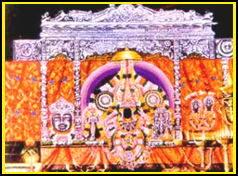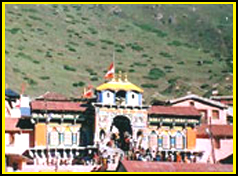|  Badrinath,
located in the lofty Himalayan heights 10400 feet above sea level
is a pilgrimage center held in the greatest esteem all over India.
It is an arduous mountain route to Badrinath from Rishikesh or Haridwar
in the Garwahl Himalayan region, where roads get blocked with landslides
during the monsoon season. Badrinath stays closed for 6 months a
year from Deepavali to the full moon day in the month of Chittirai
(late spring in the Himalayas). Badrinath,
located in the lofty Himalayan heights 10400 feet above sea level
is a pilgrimage center held in the greatest esteem all over India.
It is an arduous mountain route to Badrinath from Rishikesh or Haridwar
in the Garwahl Himalayan region, where roads get blocked with landslides
during the monsoon season. Badrinath stays closed for 6 months a
year from Deepavali to the full moon day in the month of Chittirai
(late spring in the Himalayas).
Enroute is the pilgrimage sites of Pandukeswar where the Pandavas
are believed to have been born, and the site where Bhima and Hanuman
(sons of Vayu) met. One must also see the Pancha Prayags in this
route, which are
Dev Prayag(Confluence of Bhagirathi and Alaknanda)
Rudra Prayag(Confluence of Alaknanda and Mandakini)
Karna Prayag(Confluence of Pindari River and Alaknanda)
Nanda Prayag(Confluence of Alaknanda and Nandakini)
Vishnu Prayag(Confluence of Vishnu Ganga and Dhauliganga)
Hot water springs of Taptakundam
are seen on the banks of the Alaknanda at Badrinath and pilgrims
take bath here before visiting the temple. The lofty peaks Neelakanta
Parvatam and Nara Narayana Parvatam are visible from the temple.
The image of Badrinarayanar here is fashioned out of Saligramam.
Badrrinarayana is seen under the badari tree, flanked by Kuberan
and Garudan, Naradar, Narayana and Nara. Mahalakshmi (referred to
as Aravindavalli in the Sree Vaishnava tradition) has a sanctum
in the prakaram. There is also a shrine to Adi Sankarar.
The Bhrama Kapalam north of the temple on the banks of the Ganga,
is the site of performance of remembrance rites for the ancestors.
Behind the temple of Badrinarayanar is the Lakshmi Narasimha mandir,
with shrines to Desikacharyar and Ramanujacharya.
Periyalwar states that Vishnu enshrined in Mathura, Salagramam,
Dwaraka, Ayodhya and Sree Vaikuntam is the same as the one (Purushottaman)
enshrined in Tirukkandam or Kadinagar (Devaprayag).
While visiting Badrinath, one must take the
opportunity to visit Pancha Badri (Five Badris)
The Pancha Badri consists of five shrines devoted to Lord Vishnu.
The five badris- Badri Vishal(Badrinath), Yogadhyan Badri, Bhavishya
Badri, Vridha Badri and Adi Badri are revered by all.Most of these
places are approachable by motorable road although trekking is inevitable
in certain places.
Vishal Badri (Badrinath temple)
 Badrinath
temple is also known as Vishal Badri. It is the largest and the
most popular of the pilgrimages among the five badris. The original
temple here is believed to be built by King Pururava and the icon
of the lord carved by Vishwakarma. The idol was recovered by Adi
Shankaracharya from the waters of the nearby Naradakundam and consecrated
once more in the temple , restored in the 19th century by the royal
houses of Scindia and Holkar. The epic Mahabharatha is believed
to be composed in the Vyasa and Ganesha caves close by. The Vishnu
Ganga which later becomes the Alaknanda flows below the temple with
Neelkanth Parvath on the other side. Mana Village is a fascinating
village , the last habitation before the border with China, which
once had a flourishing trade relations with Tibet.
The Vasudhara falls are quite spectacular. Badrinath
temple is also known as Vishal Badri. It is the largest and the
most popular of the pilgrimages among the five badris. The original
temple here is believed to be built by King Pururava and the icon
of the lord carved by Vishwakarma. The idol was recovered by Adi
Shankaracharya from the waters of the nearby Naradakundam and consecrated
once more in the temple , restored in the 19th century by the royal
houses of Scindia and Holkar. The epic Mahabharatha is believed
to be composed in the Vyasa and Ganesha caves close by. The Vishnu
Ganga which later becomes the Alaknanda flows below the temple with
Neelkanth Parvath on the other side. Mana Village is a fascinating
village , the last habitation before the border with China, which
once had a flourishing trade relations with Tibet.
The Vasudhara falls are quite spectacular.
Yogadhyan Badri
Yogadhyan Badri is located at 1,920 meters in
Pandukeshwar, named after the Pandava kings. It is believed that
the Pandavas, victorious after their battle against the Kauravas,
but emotionally disturbed came to the Himalayas. It was here that
they handed over their capital Hastinapur to king Parikshit Raja
and took up penance. The importance of this Badri is immense and
the Lord is seen in a meditative posture. From the main road the
temples can be seen and are located slightly at a lower level leading
through a small strip of steps.
Bhavishya Badri
The future Badri is located at 2,744 meters
amidst the thick forest surrounding Tapovan. The local people believe
say that the Nara and Narayana mountains in Badri are slowly drfiting
and will collide with each other. The present Badri will be no more
with such collision and landslides. It is believed that it is here
that all devotees will throng once Badrinath will be no more. Enshrined
here is the self–forming image of the Lord. Bhavishya Badri
is connected by a motorable road upto Saldhar, which is 19 kms from
Joshimath. From Saldhar, pilgrims have to trek upto 6 kms. upto
the shrine. The trek is difficult in very steep mountains with not
very comfortable path. It is advisable to take the local people
to lead the way and better to go in a group through the paths in
almost a jungle. People who are comfortable in riding in ponies
can do that from a village which is about 2 kms from the main road
up to the hill. Villagers are very cordial and helpful and respect
all the pilgrims who visit the shrine. It requires one full day
to trek up and down the hill with frequent rests. Visitors pass
the serene Tapovan known for hot water springs.
Vridha Badri
This is the first Badri which is located at
a height of 1,380 meters at Animath 8 kms short of Joshimath. It
is believed that before Badrinath was consecrated by Adi shankaracharya,
the idol of Badrinath carved by Vishwakarma was enshrined and worshipped
here. It is said that when mankind entered the age of Kali, Vishnu
chose to remove himself from the temple.
Adi Badri
This is a group of 16 temples en route to Ranikhet
and close to the confluence of Karnaprayag. It’s about 19
kms from Karnaprayag. The main temple is dedicated to Narayanan
and has a raised platform in a pyramidal form. It is believed that
these temples dating to the Gupta Age were sanctioned by Adi shankracharya
Thaayaar - Aravindavalli.
Theertham - Tapthakundam.
|


 Badrinath,
located in the lofty Himalayan heights 10400 feet above sea level
is a pilgrimage center held in the greatest esteem all over India.
It is an arduous mountain route to Badrinath from Rishikesh or Haridwar
in the Garwahl Himalayan region, where roads get blocked with landslides
during the monsoon season. Badrinath stays closed for 6 months a
year from Deepavali to the full moon day in the month of Chittirai
(late spring in the Himalayas).
Badrinath,
located in the lofty Himalayan heights 10400 feet above sea level
is a pilgrimage center held in the greatest esteem all over India.
It is an arduous mountain route to Badrinath from Rishikesh or Haridwar
in the Garwahl Himalayan region, where roads get blocked with landslides
during the monsoon season. Badrinath stays closed for 6 months a
year from Deepavali to the full moon day in the month of Chittirai
(late spring in the Himalayas).